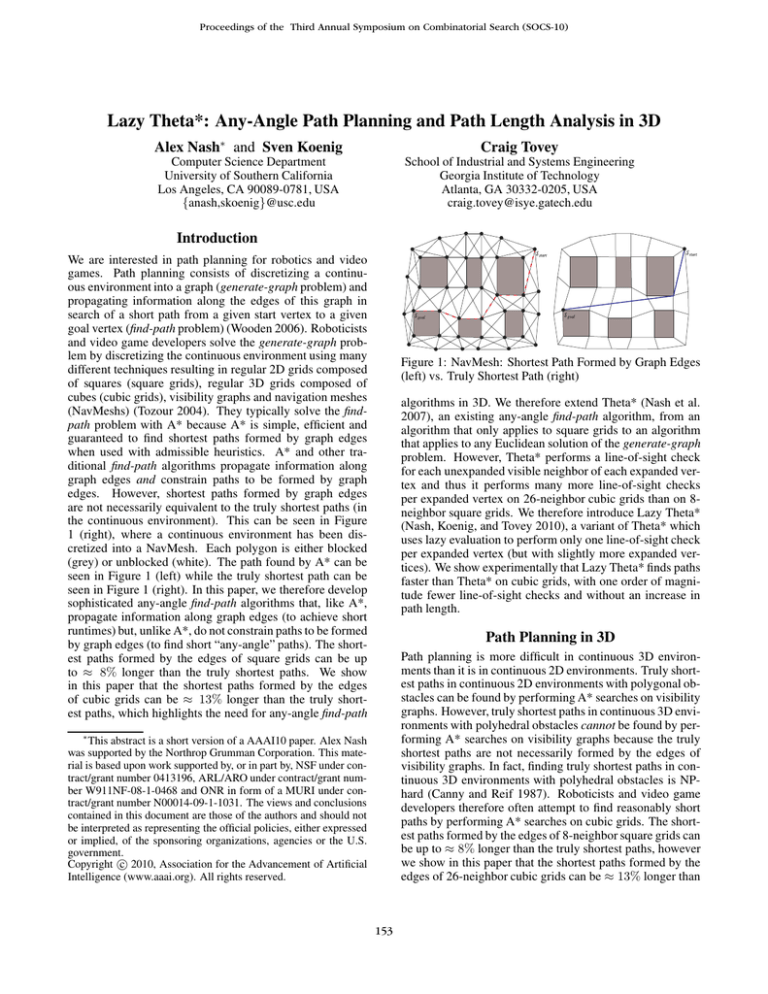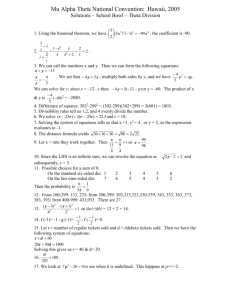
Proceedings of the Third Annual Symposium on Combinatorial Search (SOCS-10)
Lazy Theta*: Any-Angle Path Planning and Path Length Analysis in 3D
Alex Nash∗ and Sven Koenig
Craig Tovey
Computer Science Department
University of Southern California
Los Angeles, CA 90089-0781, USA
{anash,skoenig}@usc.edu
School of Industrial and Systems Engineering
Georgia Institute of Technology
Atlanta, GA 30332-0205, USA
craig.tovey@isye.gatech.edu
Introduction
We are interested in path planning for robotics and video
games. Path planning consists of discretizing a continuous environment into a graph (generate-graph problem) and
propagating information along the edges of this graph in
search of a short path from a given start vertex to a given
goal vertex (find-path problem) (Wooden 2006). Roboticists
and video game developers solve the generate-graph problem by discretizing the continuous environment using many
different techniques resulting in regular 2D grids composed
of squares (square grids), regular 3D grids composed of
cubes (cubic grids), visibility graphs and navigation meshes
(NavMeshs) (Tozour 2004). They typically solve the findpath problem with A* because A* is simple, efficient and
guaranteed to find shortest paths formed by graph edges
when used with admissible heuristics. A* and other traditional find-path algorithms propagate information along
graph edges and constrain paths to be formed by graph
edges. However, shortest paths formed by graph edges
are not necessarily equivalent to the truly shortest paths (in
the continuous environment). This can be seen in Figure
1 (right), where a continuous environment has been discretized into a NavMesh. Each polygon is either blocked
(grey) or unblocked (white). The path found by A* can be
seen in Figure 1 (left) while the truly shortest path can be
seen in Figure 1 (right). In this paper, we therefore develop
sophisticated any-angle find-path algorithms that, like A*,
propagate information along graph edges (to achieve short
runtimes) but, unlike A*, do not constrain paths to be formed
by graph edges (to find short “any-angle” paths). The shortest paths formed by the edges of square grids can be up
to ≈ 8% longer than the truly shortest paths. We show
in this paper that the shortest paths formed by the edges
of cubic grids can be ≈ 13% longer than the truly shortest paths, which highlights the need for any-angle find-path
Figure 1: NavMesh: Shortest Path Formed by Graph Edges
(left) vs. Truly Shortest Path (right)
algorithms in 3D. We therefore extend Theta* (Nash et al.
2007), an existing any-angle find-path algorithm, from an
algorithm that only applies to square grids to an algorithm
that applies to any Euclidean solution of the generate-graph
problem. However, Theta* performs a line-of-sight check
for each unexpanded visible neighbor of each expanded vertex and thus it performs many more line-of-sight checks
per expanded vertex on 26-neighbor cubic grids than on 8neighbor square grids. We therefore introduce Lazy Theta*
(Nash, Koenig, and Tovey 2010), a variant of Theta* which
uses lazy evaluation to perform only one line-of-sight check
per expanded vertex (but with slightly more expanded vertices). We show experimentally that Lazy Theta* finds paths
faster than Theta* on cubic grids, with one order of magnitude fewer line-of-sight checks and without an increase in
path length.
Path Planning in 3D
Path planning is more difficult in continuous 3D environments than it is in continuous 2D environments. Truly shortest paths in continuous 2D environments with polygonal obstacles can be found by performing A* searches on visibility
graphs. However, truly shortest paths in continuous 3D environments with polyhedral obstacles cannot be found by performing A* searches on visibility graphs because the truly
shortest paths are not necessarily formed by the edges of
visibility graphs. In fact, finding truly shortest paths in continuous 3D environments with polyhedral obstacles is NPhard (Canny and Reif 1987). Roboticists and video game
developers therefore often attempt to find reasonably short
paths by performing A* searches on cubic grids. The shortest paths formed by the edges of 8-neighbor square grids can
be up to ≈ 8% longer than the truly shortest paths, however
we show in this paper that the shortest paths formed by the
edges of 26-neighbor cubic grids can be ≈ 13% longer than
∗
This abstract is a short version of a AAAI10 paper. Alex Nash
was supported by the Northrop Grumman Corporation. This material is based upon work supported by, or in part by, NSF under contract/grant number 0413196, ARL/ARO under contract/grant number W911NF-08-1-0468 and ONR in form of a MURI under contract/grant number N00014-09-1-1031. The views and conclusions
contained in this document are those of the authors and should not
be interpreted as representing the official policies, either expressed
or implied, of the sponsoring organizations, agencies or the U.S.
government.
c 2010, Association for the Advancement of Artificial
Copyright Intelligence (www.aaai.org). All rights reserved.
153
the truly shortest paths. Thus, neither A* searches on visibility graphs nor A* searches on cubic grids work well in
continuous 3D environments. We therefore develop more
sophisticated find-path algorithms.
line-of-sight checks per expanded vertex on 26-neighbor cubic grids than on 8-neighbor square grids. We therefore
reduce the number of line-of-sight checks that Theta* performs. Our inspiration is provided by PRMs, where lazy
evaluation has been used to reduce the number of line-ofsight checks (collision checks) by delaying them until they
are absolutely necessary (Bohlin and Kavraki 2000). We
therefore introduce Lazy Theta*, a variant of Theta* which
uses lazy evaluation to perform only one line-of-sight check
per expanded vertex (but with slightly more expanded vertices), while Theta* performs a line-of-sight check for each
unexpanded visible neighbor of each expanded vertex.
Lazy Theta*, like Theta*, considers Path 2. However, unlike Theta, Lazy Theta* optimistically assumes that s′ and
parent(s) have line-of-sight without performing a line-ofsight check. Thus, it delays the line-of-sight check and
considers only Path 2. This assumption may be incorrect.
Therefore, Lazy Theta* performs the line-of-sight check immediately before expanding vertex s′ . If s′ and parent(s′ )
indeed have line-of-sight, then the assumption was correct
and Lazy Theta* does not change the g-value and parent
of s′ . If s′ and parent(s′ ) do not have line-of-sight, then
Lazy Theta* updates the g-value and parent of s′ according
to Path 1 by considering the path from sstart to each expanded
visible neighbor s′′ of s′ and from s′′ to s′ in a straight line
and choosing the shortest such path.
Notation and Definitions
Cubic grids are 3D grids composed of (blocked and unblocked) cubic grid cells, whose corners form the set of all
vertices V . sstart ∈ V is the start vertex of the search, and
sgoal ∈ V is the goal vertex of the search. The visible neighbors of vertex s are the neighbors of s with line-of-sight to
s.
A*
Theta* and Lazy Theta* build on A*. To focus its search,
A* uses an h-value for every vertex s, that approximates the
goal distance of the vertex. A* maintains two values for every vertex s: (1) The g-value g(s) is the length of the shortest
path from sstart to s found so far. (2) The parent parent(s)
which is used to extract the path after the search halts by following the parent pointers from sgoal to sstart . A* updates the
g-value and parent of an unexpanded visible neighbor s′ of
a vertex s by considering the path from sstart to s and from
s to s′ in a straight line. It updates the g-value and parent of
s′ if this new path is shorter than the shortest path from sstart
to s′ found so far.
A* finds shortest paths formed by graph edges when used
with admissible heuristics. We proved that the shortest paths
formed by the edges of 26-neighbor cubic grids and thus
the paths found by A* can be ≈ 13% longer than the truly
shortest paths.
Experimental Results
We now compare the average path lengths, number of vertex expansions, number of line-of-sight checks and runtimes of Theta* and Lazy Theta when finding paths on
100 × 100 × 100 26-neighbor cubic grids. The start vertex
is always the origin (0, 0, 0), and the goal vertex is (99, y, z)
for randomly chosen values of y and z. We make the following observations. Path Length: The lengths of the paths
found by Lazy Theta* and Theta* are similar to one another
and ≈ 8% shorter than the lengths of the paths found by A*.
Vertex Expansions: Lazy Theta* expands more vertices than
Theta*. Line-of-Sight Checks: Lazy Theta* performs more
than one order of magnitude fewer line-of-sight checks than
Theta*. Runtime: Lazy Theta* is up to ≈ 1.6 times faster
than Theta*.
Existing Work: Theta*
Theta* is an any-angle find-path algorithm that empirically
finds shorter paths on square grids than A* with a similar
runtime (Nash et al. 2007). The key difference between
Theta* and A* is that Theta* allows the parent of a vertex to
be any vertex, while A* restricts the parent of a vertex to be
a neighbor of that vertex. Theta* is identical to A* except
that Theta* updates the g-value and parent of an unexpanded
visible neighbor s′ of a vertex s by considering two paths:
Path 1: Like A*, Theta* considers the path from sstart to
s and from s to s′ in a straight line. Path 2: To allow for
any-angle paths, Theta* also considers the path from sstart
to parent(s) and from parent(s) to s′ in a straight line. It
considers Path 2 if s′ and parent(s) have line-of-sight since
Path 2 is guaranteed to be no longer than Path 1 due to the
triangle inequality. Otherwise, it considers Path 1. Theta*
updates the g-value and parent of s′ if the considered path is
shorter than the shortest path from sstart to s′ found so far.
References
Bohlin, R., and Kavraki, L. 2000. Path planning using lazy PRM.
In Proceedings of the IEEE Transactions on Robotics and Automation.
Canny, J., and Reif, J. 1987. New lower bound techniques for
robot motion planning problems. In Proceedings of the Symposium
on the Foundations of Computer Science.
Nash, A.; Daniel, K.; Koenig, S.; and Felner, A. 2007. Theta*:
Any-angle path planning on grids. In Proceedings of the AAAI
Conference on Artificial Intelligence.
Nash, A.; Koenig, S.; and Tovey, C. 2010. Lazy Theta*: Any-angle
path planning and path length analysis in 3D. In Proceedings of the
AAAI Conference on Artificial Intelligence.
Tozour, P. 2004. Search space representations. In Rabin, S., ed.,
AI Game Programming Wisdom 2. Charles River Media. 85–102.
Wooden, D. 2006. Graph-based Path Planning for Mobile Robots.
Ph.D. Dissertation, Georgia Institute of Technology.
Extending Theta*: Lazy Theta*
Theta* is slower on cubic grids than square grids because
it performs a line-of-sight check for each unexpanded visible neighbor of each expanded vertex. Line-of-sight checks
on grids can be implemented efficiently with line drawing
algorithms, but the runtime per line-of-sight check can still
be linear in the number of cells and there are many more
154




